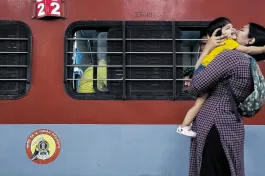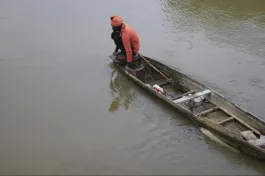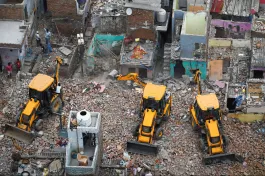Sooner or later, India will have to move away from coal as its primary energy source, given the looming climate-change-induced disasters that await many South Asian countries if immediate steps are not taken. But the transition away from coal is complex and challenging because of the entanglement of coal with the livelihoods of local communities, revenue generation at multiple levels, besides a surge in energy demand. Thus, India at the Glasgow COP 26 committed to a 'phase down of unabated coal power' rather than a 'phase out' of coal. However, the country's actions are quite contradictory to the global discourse: the rhetoric of renewables arises from concerns of energy security rather than climate justice.
Job losses and the retraining and reskilling of coal miners are dominant concerns for a 'just transition'. This poses a particular challenge for India, where the coal sector has a massive proportion of informal labour (mostly unaccounted), drawn from migrant and local mining-affected communities. Any 'just transition' discourse has to bring together climate justice and labour justice. The hazardous and precarious labour of diverse sets of informal workers in the coalfields should be foregrounded to discuss the alternative imaginaries and transformation towards more dignified, safe and better jobs. The highly exploitative working conditions and depletion of bodies provide an opening to reflect upon the futures of informal workers.
Informal labour in the coalfields
My long-term ethnographic research, between 2018-2020 at the Talcher coalfields in Odisha, maps the labouring conditions of informal workers in and around coal mines. The coalfields fields are operated by a subsidiary of the public sector unit Coal India Ltd, Mahanadi Coalfields, which was the largest coal producing company in India in 2021-22.
Since liberalisation in the 1990s, informal employment at the bottommost of the labour hierarchy has become extremely diverse (De Neve 2019). A large and booming share of the informal labour that works in the coal sector may not directly contribute to the production of coal as a commodity. Outsourcing through private companies and local contractors supplying labour have steadily expanded in the public sector coal mines (Nayak 2022). Unfortunately, informal workers are not systematically recorded by any official database. "They play with numbers; many informal workers never appear on papers," a union leader told me.
In Talcher, on average in a month, about 9,250 registered contract and casual workers are engaged in exploitative informal labour of mining and allied activities in and around the mines (all data are from my fieldwork, unless otherwise cited.) In 2018, two-thirds of them were engaged in mining activities (wagon loading, coal extraction, transportation of coalfrom stock to railway siding, overburden removal and dumping) under different subcontractors. The rest worked as security guards, in civil and construction works, at coal handling plants, and in electrical and mechanical works. Another 12,000-15,000 worked as drivers and helpers in trucks that transported the coal. Two private coal washeries, which reduce the ash content of coal, employ roughly 500 casual labourers, besides 900-1200 of their permanent employees. (Not all the workers are recorded on paper and it is possibile that many workers are left out from statistics shared by management officials and workers during interviews.)
The labour contractors successfully create a discourse around women workers as not desired for long hours of work…[which] minimises their scope for any negotiation…
Informal workers are engaged in the most precarious forms of work with increasing casualisation, job insecurities and hazardous forms of work. The large share of casual labourers is categorised as 'unskilled' – a much-needed but devalued diverse set of jobs. How skill is defined and valued are socially and politically constructed in any work and industry (Gooptu 2018). 'Skill' as a social relation intersects with social structures such as caste, gender and ethnicity (Prasad-Aleyamma, 2017). In Talcher, marginalised communities, particularly landless Dalits and lower-class peasants from neighbouring villages and Adivasi migrants from the western region of the state, primarily make the 'unskilled' labourers in this coalfield.
In the hypermasculine spaces of the coal industry, some occupations are more valued than others. Machine operators are the most regarded, followed by mechanics. However, the same tasks of overburden removal or coal extraction performed by contractual workers, recruited by outsourced companies as 'tipper drivers' in place of the permanent workers as 'dumper operators', are valued differently
In the coalfields, the informal workers at the very bottom of the hierarchy labour in diverse settings: processing coal in the washeries or handling plants, constructing roads and buildings, manual labour in railway sidings, SILO and other stockyards, repair works and other activities including sweeping, gardening, domestic help in the homes of mine officials. Each activity has its own set of work processes, work-time rhythm and labour control strategies, which fall under the term of 'unskilled' labour.
The hardest physical labour of the coal cleaners working in coal washeries and handling plants is valued the least. Their ability to endure long hours of physical labour in continuous showers of coal dust, understanding of the functioning of machineries, unimaginable control of breathing, sustaining the spells of suffocation, maintaining sharp observations to pick foreign materials such as stones and big chunk of coal which needs to be further crushed, climbing up the circuits, use of electric vibrators and hand shovels for crushing coal, and cleaning coal slurry attributes to the category -'unskilled'.
The social construction of skill is closely tied to wages. The more the devaluation of skill, the more precarious the wages are.
Without their so-called 'unskilled' labour, the machines may choke and bring the plants to a complete halt. "Casual workers are majdoors (labourers) at the bottommost but are 'experts'," an engineer at a private coal washery explained. "Engineers are always around, but sometimes they are not there. Then workers also operate the machine since they know the sections pretty well and are trained by us on safety precautions."
And yet: "if they do some badmashi (mischief) like they are not working or relaxing, taking breaks often, they misbehave or have a quarrel with co-workers, or they give jawabs (talk back) to seniors, then they are shifted to different sections as punishment."

The social construction of skill is closely tied to wages. The more the devaluation of skill, the more precarious the wages are. The much needed but unworthy labour of casual labourers, particularly coal cleaners, pays hardly between Rs 250-300 per work shift, which gives them roughly Rs 6,000-7,000 per month.
This puts extreme pressure on the workers for their daily sustenance. Adding to the precarity is a delay in wages, non-payment of provident funds for years, periodic discontinuation for avoiding the payment of provident funds, deducting wages for buying equipment such as hand shovels, boots and helmets, and many more other accumulating strategies by the contractors. The labour contractors successfully create a discourse around women workers as not desired for long hours of work in coal mines and other allied industries. This minimises their scope for any negotiation, by showing that recruitment is a mere act of generosity. Many times, this results in less wages than paid to men.
Both contractors and mines management turned a blind eye to coal scavenging by the casual labourers as the burden of social reproduction shifts on the workers…
Coal cleaners resort to other jobs such as carpentry, farming, painting, mechanical works on weekly rest days. Coal scavenging on the side provides for the sustenance and reproduction of their generations. Workers pick up coal from abandoned coal mines, from what falls off loaded and trains onto railway tracks, or from stockyards and sale dumps. This coal is – illegally – sold to other households in their village, neighbouring villages and towns, to motels, brick kilns factories, small shops, and to the coal mafias, besides for their self-consumption.
The coal cleaners consider themselves as 'part-time' coal scavengers, operating in broad daylight after their shift, often in the sight of management. "[The bosses at MCL] know about our low wages. They are very sympathetic and never tell us anything if we scavenge coal," Babu, a 52-year-old coal cleaner at the coal handling plant said. This was unlike the case for 'full-time' coal scavengers, a set of informal labourers who scavenged coal at night or in the early morning, when the chances of getting caught are least.
The current discourse of livelihoods dependence on coal should also accompany the discussions around exploitative and precarious labour regimes of coal production.
Many management officials, including foremen and engineers, said that the casual labourers work very hard and get low wages, which they feel is unfair. Still, they cannot say much to the contractors, so they let them survive on coal scavenging. Both contractors and mines management turned a blind eye to coal scavenging by the casual labourers as the burden of social reproduction shifts on the workers by coal scavenging, which reduces conflict and negotiations over wages by the workers.
The future of transformative justice
The depletion of bodies is part of the labouring processes at the coalfields. Coal production demands production of precarious bodies, with bare sustenance and to whom death can strike at any time. Coal pollution at work and polluted water is slowly killing those living in coal fields neighbourhoods, especially the migrant workers living in bastis attached to mining areas. Accidents are part and parcel of their daily lives. Unlike formal workers, the casual labourers have no provision to be treated in better hospitals in the city.
"I always think what about my lungs. It must be black like coal by now," said Sita, a 30-year-old coal cleaner.
"Whatever you do, coal is in our body, in our blood".
Recent discussions on the climate crisis and 'just transition' away from coal across the globe have drawn new attention to coal as a resource, its use, and its impacts on nature, labour and communities. But the complexities and precarity of informal workers I describe point towards the need for structurally transformative justice.
The current discourse of livelihoods dependence on coal should also accompany the discussions around exploitative and precarious labour regimes of coal production. Communities depend on coal for their livelihoods. However, they share diverse socio-economic-political positions and are at the intersections of inequalities. Workers at these intersections undergo varied processes of exploitation for production of coal as a commodity. Just transition is the moment of socio-economic churning of these inequalities, and transformation from these unequal and exploitative relations should be on the agenda.
Transformative justice requires not just deep restructuring or universal inclusivity alone, but rather the combination that grants all people, representing diverse socio-economic positions, the power to influence future alternative energy systems (Wilgosh et.al, 2022 pg, 8). Myopic understanding of just transition and the question of labour in the coal heartlands will neither bring transformative justice nor mobilisation of labour around energy transitions. The strategies of retraining workers (Roy et.al 2021) have to account for the diversity in the labour landscape, especially in informal labour, moving beyond a 'fair treatment for all' strategy.
Suravee Nayak is a PhD candidate at the Centre for Development Studies, Thiruvananthapuram. This article draws from her ongoing research.









